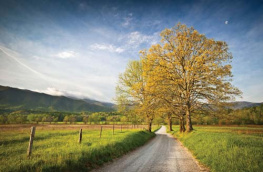THE GREAT SMOKY MOUNTAINS

Puffy Clouds Dot the Sky. Cades Cove .
Lee Mandrell and DeeDee Niederhouse-Mandrell
Foreword by Steve Kemp
THE
GREAT SMOKY MOUNTAINS
A VISUAL JOURNEY

A View from the Blue Ridge Parkway. Cherokee, North Carolina .

This book is a publication of
Indiana University Press
Office of Scholarly Publishing
Herman B Wells Library 350
1320 East 10th Street
Bloomington, Indiana 47405 USA
iupress.indiana.edu
2017 by Lee Mandrell and Diana Niederhouse-Mandrell
All rights reserved
No part of this book may be reproduced or utilized in any form or by any means, electronic or mechanical, including photocopying and recording, or by any information storage and retrieval system, without permission in writing from the publisher. The Association of American University Presses Resolution on Permissions constitutes the only exception to this prohibition.
Manufactured in China .
Library of Congress Cataloging-in-Publication Data
Names: Mandrell, Lee, photographer. | Niederhouse-Mandrell, DeeDee photographer.
Title: The Great Smoky Mountains : a visual journey / Lee Mandrell and DeeDee Niederhouse-Mandrell ; foreword by Steve Kemp.
Description: Bloomington : Indiana University Press, 2017. | Includes index.
Identifiers: LCCN 2016011853 (print) | LCCN 2016013805 (ebook) | ISBN 9780253023773 (cloth) | ISBN 9780253023889 (ebook)
Subjects: LCSH : Great Smoky Mountains National Park (N.C. and Tenn.)Pictorial works. | Great Smoky Mountains National Park (N.C. and Tenn.)Description and travel.
Classification: LCC F 443.G 7 M 19 2017 (print) | LCC F 443.G 7 (ebook) | DDC 976.8/89dc23
LC record available at http://lccn.loc.gov/2016011853
1 2 3 4 5 22 21 20 19 18 17

Fall Scenery. Roaring Fork Motor Nature Trail .
CONTENTS

Dusk. Clingmans Dome .
FOREWORD
Compared to the American West, or even the Northeast, the southeastern United States is generally considered flat. If asked to describe the geography of the region, many would conjure images of tangled swampland or white-sand Atlantic beaches.
Yet there is a very notable exception to the largely horizontal nature of this place: the southern Appalachian Mountains. Being near the southern terminus of the lengthy mountain range, the southern Appalachians are sometimes overlooked and often underestimated. It was not until the mid-nineteenth century that geographers came to accept the claim of Elisha Mitchell that the highest summit in the eastern United States was in North Carolina, not New Hampshire. Because peaks like Mount Washington have craggy faces and stony summits that protrude above the timberline, even scientists of the day assumed it was the tallest. Not so. The highest mountains east of the Mississippi River reside in North Carolina and East Tennessee, but because their summits are cloaked in evergreen forest and tend to be more rounded than craggy, their true heights deceived even the experts of the time.
The humbly handsome summits of the Great Smoky Mountains, with their famous misty blue silhouettes, are so shaped because of age. The time between being crumpled skyward by massive colliding continents and today is measured not in millions of years but in hundreds of millions of years. The eons of rain and ice have weathered the jagged upthrusts of sandstone and slate and allowed a riot of vegetation to transform the once-barren slopes into a temperate jungle. More than the bedrock beneath, this verdant cloak of vines, shrubs, trees, mosses, beetles, butterflies, warblers, and other organisms is what makes the Smokies so beautiful to behold and worthy of the exalted status of national park.
As Robert Sterling Yard, author, editor, and founding member of the Wilderness Society, put it, The Smokies are natural wonders, but they are more than that. One can see a stupendous phenomenon of naturethat awes one with its majesty; but when he has seen it oncewell, he has seen it. The Smoky Mountains have enduring charm. Having seen them once, they lure you back again and again. So there is good reason that Lee Mandrell and DeeDee Niederhouse-Mandrell have been coming to the Smokies to capture light and beauty for over twenty-five years. There is also a good reason why over nine million other people (more than two-thirds of them repeat visitors) come to the Smokies year after year. No one can stand at Carlos C. Campbell Overlook, gaze toward the heath balds and rich cove hardwood forests that populate the slopes of Mount Le Conte, get back in their car, drive home, and feel like they have seen all of the Great Smoky Mountains. More likely, they have seen just enough to whet their appetite. To want to get closer to the gin-clear streams coursing over boulders and cataracts. To see the rhododendrons in the heath balds paint the slopes pink. To see the maples and hickories and oaks in their fiery late-October hues. To see the clouds lift and reveal snow on the spruce trees near the summit of Mount Le Conte.

A Colorful Sunset Display. Clingmans Dome .
No one can see it all in the Great Smoky Mountains because there is too much to see. If you are a tree person, there are 100 different species of native arbors to behold. Birds? 240 species; some here just in summer, some just in winter, some all year, some passing through, some fleeting refugees from Atlantic hurricanes or shortages of wild foods in eastern Canada. Are you interested in salamanders? There are 30 speciessome confined to the mossy, high-elevation spruce-fir forests, while others only appear in the deeper pools of the largest rivers in the Smokies. Over 1,500 species of wildflowers have been documented here and 58 types of ferns. So diverse and abundant is life in these mountains that a special scientific effort called the All Taxa Biodiversity Inventory was launched in 1999 to lure in the biologists who could once and for all document every variety of flora and fauna living here. The answer: 18,545 taxa and still counting. In fact, every single year, researchers discover new forms of life in the park, some of them not only new to the Smokies but new to science.
Just like the scientists cataloging the parks nearly infinite biota, Lee and DeeDee have yet to complete their work here. How could they? No matter how many journeys they make, there is always a new place to go. What about New World above Tremont or the spectacular wet-weather falls near Fort Harry? Perhaps there will be a tendril of mist curling skyward from the Deep Creek Valley this fall that no one has ever photographed before, or a slant of sunlight beneath threatening clouds at dusk from Morton Overlook.














